文章目录
一、重点内容:
知识要点有哪些?
1、Gin参数的获取
2、Gin路由组
3、Gin中间件
4、Gin重定向和404
二、详细知识点介绍:
1、接上一篇的代码准备
以下是创建连接和加载资源的代码:
代码:
package main
import (
"encoding/json"
"fmt"
"github.com/gin-gonic/gin"
"github.com/thinkerou/favicon"
"log"
"net/http"
)
func main() {
// 创建一个服务
ginServer := gin.Default()
// 使用图标
ginServer.Use(favicon.New("./static/哔哩哔哩.png"))
// 加载html
ginServer.LoadHTMLGlob("templates/*")
// 加载静态资源
ginServer.Static("/static", "./static")
// 服务器端口
err := ginServer.Run(":8082")
if err != nil {
log.Panicln(err)
return
}
}
2、路由参数获取
方式一:
url:http//:localhost:8082/info/id/name
代码:
package main
import (
"encoding/json"
"fmt"
"github.com/gin-gonic/gin"
"github.com/thinkerou/favicon"
"log"
"net/http"
)
func main() {
// 创建一个服务
ginServer := gin.Default()
// 使用图标
ginServer.Use(favicon.New("./static/哔哩哔哩.png"))
// 加载html
ginServer.LoadHTMLGlob("templates/*")
// 加载静态资源
ginServer.Static("/static", "./static")
//url:`http//:localhost:8082/info/id/name`
ginServer.GET("/info/:id/:name", func(context *gin.Context) {
id := context.Param("id")
name := context.Param("name")
context.JSON(http.StatusOK, gin.H{
"id": id,
"name": name,
})
})
// 服务器端口
err := ginServer.Run(":8082")
if err != nil {
log.Panicln(err)
return
}
}
测试:

方式二:
url:http//:localhost:8082/info?id=111&name=xiaohua
代码:
package main
import (
"encoding/json"
"fmt"
"github.com/gin-gonic/gin"
"github.com/thinkerou/favicon"
"log"
"net/http"
)
func main() {
// 创建一个服务
ginServer := gin.Default()
// 使用图标
ginServer.Use(favicon.New("./static/哔哩哔哩.png"))
// 加载html
ginServer.LoadHTMLGlob("templates/*")
// 加载静态资源
ginServer.Static("/static", "./static")
//url:`http//:localhost:8082/info?id=111&name=xiaohua``
ginServer.GET("/info", func(context *gin.Context) {
id := context.Query("id")
name := context.Query("name")
context.JSON(http.StatusOK, gin.H{
"id": id,
"name": name,
})
})
// 服务器端口
err := ginServer.Run(":8082")
if err != nil {
log.Panicln(err)
return
}
}
测试:

3、Json数据接收
接收前端发送的Json数据并显示:
代码:
package main
import (
"encoding/json"
"fmt"
"github.com/gin-gonic/gin"
"github.com/thinkerou/favicon"
"log"
"net/http"
)
func main() {
// 创建一个服务
ginServer := gin.Default()
// 使用图标
ginServer.Use(favicon.New("./static/哔哩哔哩.png"))
// 加载html
ginServer.LoadHTMLGlob("templates/*")
// 加载静态资源
ginServer.Static("/static", "./static")
//JSON数据
ginServer.POST("/json", func(context *gin.Context) {
data, _ := context.GetRawData()
var m map[string]interface{
}
json.Unmarshal(data, &m)
context.JSON(http.StatusOK, m)
})
// 服务器端口
err := ginServer.Run(":8082")
if err != nil {
log.Panicln(err)
return
}
}
测试:
这里使用APIpost工具测试post请求:
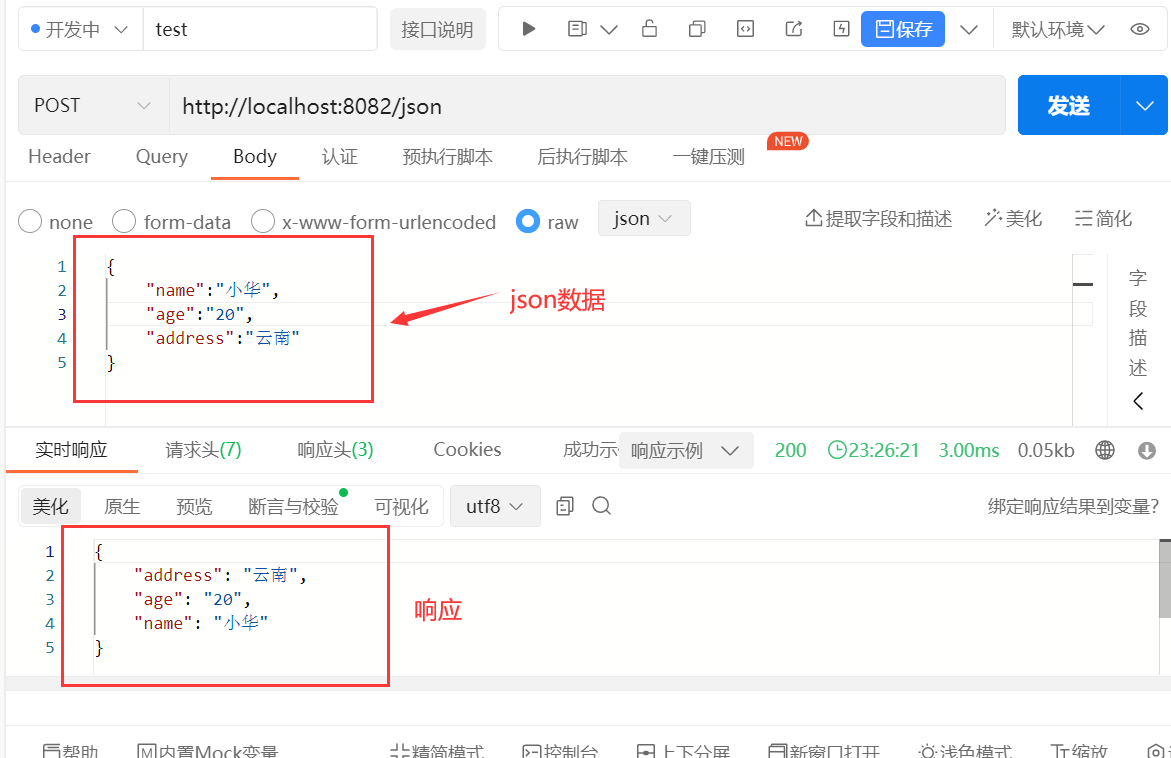
4、表单数据接收
接收前端发送的表单数据:
代码:
html:(编写表单)
<!DOCTYPE html>
<html lang="en">
<head>
<meta charset="UTF-8">
<title>go web</title>
<!-- 链接 css和js-->
<link rel="stylesheet" href="../static/css/style.css">
<script src="../static/js/common.js"></script>
</head>
<body>
<h1>
Holle!!!
</h1>
表单:
<div class="myform">
<form action="/user/add" method="post">
<p> username: <input type="text" name="username" value="name"></p>
<p> password: <input type="password" name="password" value="password"></p>
<button type="submit">提交</button>
</form>
</div>
后端发送的消息:
{
{.msg}}
{
{.session}}
<img src="https://ts1.cn.mm.bing.net/th?id=ORMS.125d9efb147fe32b7990b8282e6bd509&pid=Wdp&w=612&h=304&qlt=90&c=1&rs=1&dpr=0.9333299994468689&p=0">
</body>
</html>
go代码:
package main
import (
"encoding/json"
"fmt"
"github.com/gin-gonic/gin"
"github.com/thinkerou/favicon"
"log"
"net/http"
)
func main() {
// 创建一个服务
ginServer := gin.Default()
// 使用图标
ginServer.Use(favicon.New("./static/哔哩哔哩.png"))
// 加载html
ginServer.LoadHTMLGlob("templates/*")
// 加载静态资源
ginServer.Static("/static", "./static")
ginServer.POST("/user/add", func(context *gin.Context) {
name := context.PostForm("username")
password := context.PostForm("password")
context.JSON(http.StatusOK, gin.H{
"msg": "ok",
"username": name,
"password": password,
})
})
// 服务器端口
err := ginServer.Run(":8082")
if err != nil {
log.Panicln(err)
return
}
}
测试:
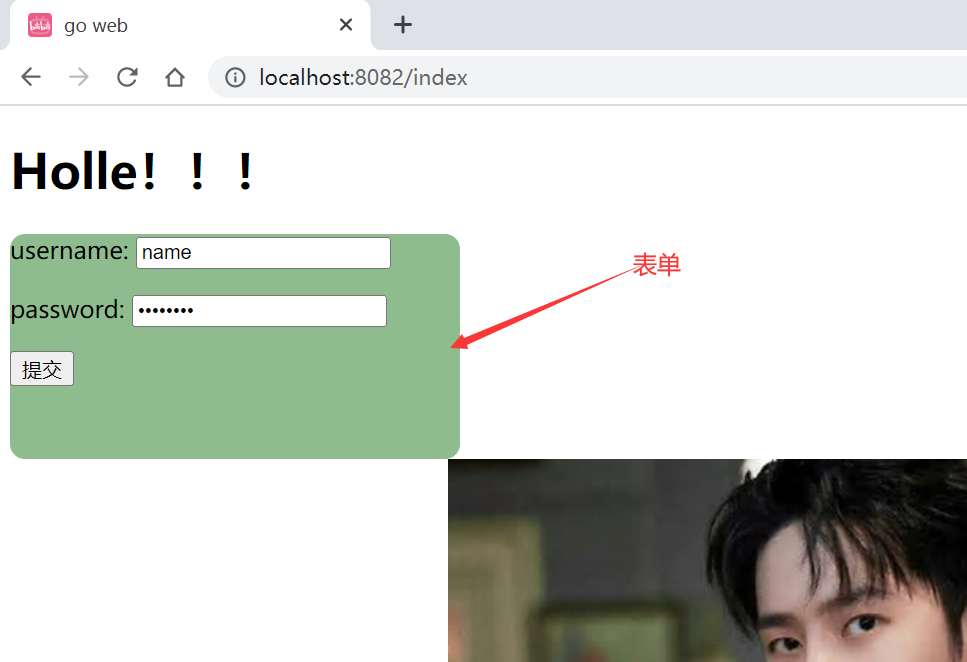
提交后:
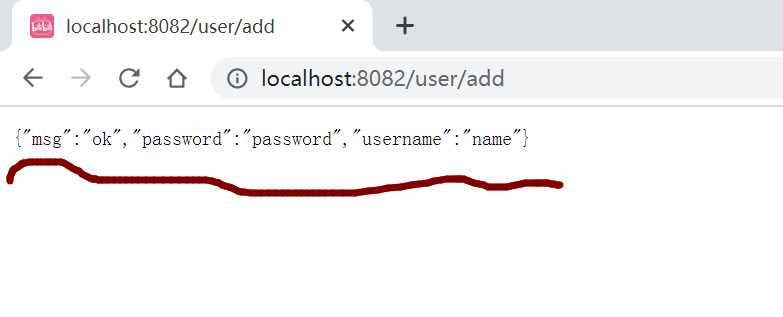
看到后端已经接收到数据了。
5、重定向
网页开发中,常见网站搬移需要进行重定向:
代码:
访问/redirect,重定向到主页/index
package main
import (
"encoding/json"
"fmt"
"github.com/gin-gonic/gin"
"github.com/thinkerou/favicon"
"log"
"net/http"
)
func main() {
// 创建一个服务
ginServer := gin.Default()
// 使用图标
ginServer.Use(favicon.New("./static/哔哩哔哩.png"))
// 加载html
ginServer.LoadHTMLGlob("templates/*")
// 加载静态资源
ginServer.Static("/static", "./static")
ginServer.GET("/redirect", func(context *gin.Context) {
context.Redirect(http.StatusMovedPermanently, "/index")
})
// 服务器端口
err := ginServer.Run(":8082")
if err != nil {
log.Panicln(err)
return
}
}
测试:


6、404页面
开发中十分常见的页面,用户访问url错误导致:
代码:
package main
import (
"encoding/json"
"fmt"
"github.com/gin-gonic/gin"
"github.com/thinkerou/favicon"
"log"
"net/http"
)
func main() {
// 创建一个服务
ginServer := gin.Default()
// 使用图标
ginServer.Use(favicon.New("./static/哔哩哔哩.png"))
// 加载html
ginServer.LoadHTMLGlob("templates/*")
// 加载静态资源
ginServer.Static("/static", "./static")
ginServer.NoRoute(func(context *gin.Context) {
context.HTML(404, "404.html", nil)
})
// 服务器端口
err := ginServer.Run(":8082")
if err != nil {
log.Panicln(err)
return
}
}
创建一个响应的404.html:
<!DOCTYPE html>
<html lang="en">
<head>
<meta charset="UTF-8">
<title>404 not found</title>
</head>
<body>
<h1>网页走丢了!!!!</h1>
</body>
</html>
测试:
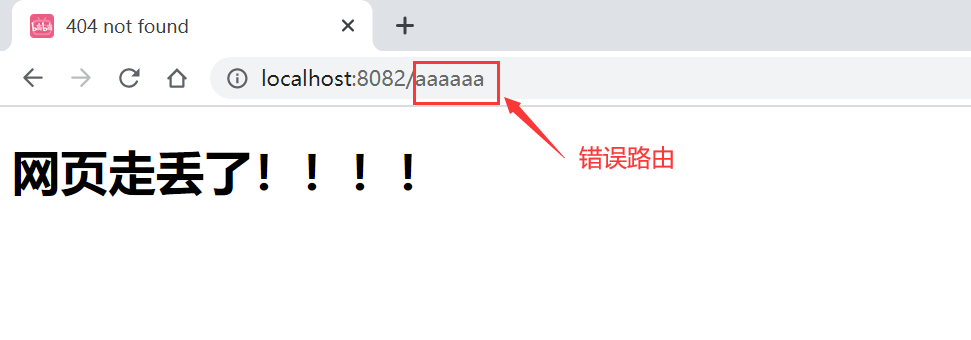
7、路由群组
代码:
package main
import (
"encoding/json"
"fmt"
"github.com/gin-gonic/gin"
"github.com/thinkerou/favicon"
"log"
"net/http"
)
func main() {
// 创建一个服务
ginServer := gin.Default()
// 使用图标
ginServer.Use(favicon.New("./static/哔哩哔哩.png"))
// 加载html
ginServer.LoadHTMLGlob("templates/*")
// 加载静态资源
ginServer.Static("/static", "./static")
routerGroup := ginServer.Group("/user")
{
routerGroup.GET("/login", func(context *gin.Context) {
context.JSON(http.StatusOK, gin.H{
"login": "ok",
})
})
routerGroup.GET("/logout", func(context *gin.Context) {
context.JSON(http.StatusOK, gin.H{
"logout": "ok",
})
})
}
// 服务器端口
err := ginServer.Run(":8082")
if err != nil {
log.Panicln(err)
return
}
}
测试:
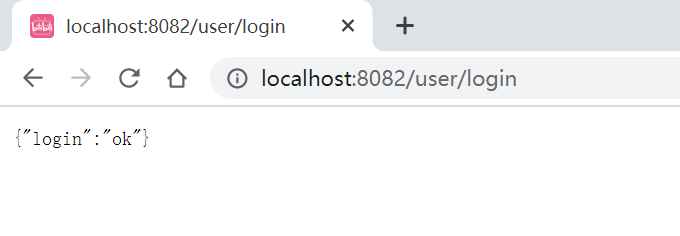

8、中间件
分类使用方式
// 1.全局中间件
router.Use(gin.Logger())
router.Use(gin.Recovery())
// 2.单路由的中间件,可以加任意多个
router.GET("/benchmark", MyMiddelware(), benchEndpoint)
// 3.群组路由的中间件
authorized := router.Group("/", MyMiddelware())
// 或者这样用:
authorized := router.Group("/")
authorized.Use(MyMiddelware())
{
authorized.POST("/login", loginEndpoint)
}
自定义中间件:
(传输全局session)
代码:
package main
import (
"encoding/json"
"fmt"
"github.com/gin-gonic/gin"
"github.com/thinkerou/favicon"
"log"
"net/http"
)
/*
*
自定义中间件
*/
func myHandler() gin.HandlerFunc {
return func(context *gin.Context) {
context.Set("session", "ok")
context.Next()
// context.Abort()
}
}
func main() {
// 创建一个服务
ginServer := gin.Default()
// 使用图标
ginServer.Use(favicon.New("./static/哔哩哔哩.png"))
// 加载html
ginServer.LoadHTMLGlob("templates/*")
// 加载静态资源
ginServer.Static("/static", "./static")
ginServer.GET("/index", myHandler(), func(context *gin.Context) {
value, exists := context.MustGet("session").(string)
if !exists {
fmt.Println("找不到session")
}
fmt.Println("session:>>>>", value)
context.HTML(http.StatusOK, "index.html", gin.H{
"msg": "服务器发送的html",
"session": value,
})
})
// 服务器端口
err := ginServer.Run(":8082")
if err != nil {
log.Panicln(err)
return
}
}
测试:

9、控制器
- 数据解析绑定
模型绑定可以将请求体绑定给一个类型,目前支持绑定的类型有 JSON, XML 和标准表单数据 (foo=bar&boo=baz)。
要注意的是绑定时需要给字段设置绑定类型的标签。比如绑定 JSON 数据时,设置 json:"fieldname"。
使用绑定方法时,Gin 会根据请求头中 Content-Type 来自动判断需要解析的类型。如果你明确绑定的类型,你可以不用自动推断,而用 BindWith 方法。
你也可以指定某字段是必需的。如果一个字段被 binding:"required" 修饰而值却是空的,请求会失败并返回错误。
// Binding from JSON
type Login struct {
User string `form:"user" json:"user" binding:"required"`
Password string `form:"password" json:"password" binding:"required"`
}
func main() {
router := gin.Default()
// 绑定JSON的例子 ({"user": "manu", "password": "123"})
router.POST("/loginJSON", func(c *gin.Context) {
var json Login
if c.BindJSON(&json) == nil {
if json.User == "manu" && json.Password == "123" {
c.JSON(http.StatusOK, gin.H{
"status": "you are logged in"})
} else {
c.JSON(http.StatusUnauthorized, gin.H{
"status": "unauthorized"})
}
}
})
// 绑定普通表单的例子 (user=manu&password=123)
router.POST("/loginForm", func(c *gin.Context) {
var form Login
// 根据请求头中 content-type 自动推断.
if c.Bind(&form) == nil {
if form.User == "manu" && form.Password == "123" {
c.JSON(http.StatusOK, gin.H{
"status": "you are logged in"})
} else {
c.JSON(http.StatusUnauthorized, gin.H{
"status": "unauthorized"})
}
}
})
// 绑定多媒体表单的例子 (user=manu&password=123)
router.POST("/login", func(c *gin.Context) {
var form LoginForm
// 你可以显式声明来绑定多媒体表单:
// c.BindWith(&form, binding.Form)
// 或者使用自动推断:
if c.Bind(&form) == nil {
if form.User == "user" && form.Password == "password" {
c.JSON(200, gin.H{
"status": "you are logged in"})
} else {
c.JSON(401, gin.H{
"status": "unauthorized"})
}
}
})
// Listen and serve on 0.0.0.0:8080
router.Run(":8080")
}
三、课后个人总结:
这节课接着上节课,完备的学习了Gin框架的常见使用方式,并一一实践,收获颇丰。